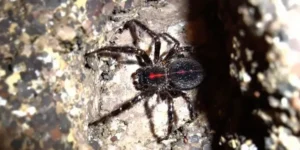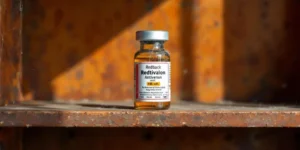Redback spider bites can be frightening and cause significant discomfort. These spiders are frequently found in Australia, and their bites pose potential health risks. This post will present redback spider bite pictures and explain the identifying features.
We’ll examine these hazardous bites in detail.
Key Takeaways
- Redback spider bites often don’t leave clear marks. Only 5% show two tiny fang marks.
- Bite symptoms include severe pain, headaches, nausea, and unusual sweating. Men may have a painful erection.
- First aid: Clean the bite, apply a cold pack, take pain relief, and seek medical help right away.
- No deaths from redback bites since 1956 when antivenom became available. Before that, only 13 deaths occurred.
- Prevent bites by wearing gloves, removing clutter, sealing cracks, and checking outdoor areas carefully.

What Does a Redback Spider Bite Look Like?

Redback spider bites often go undetected initially. Most bites don’t leave obvious marks. Only about 5% of bites show two tiny fang marks. The bite area may turn red and swell slightly.
Mild pain might begin immediately or develop over a few hours.
These bites can be difficult to identify. The female redback spider is small, measuring just 1 cm in length. She has a black body with a red-orange stripe or spot on her back. This makes her easily identifiable, but her bite isn’t always apparent.
If you suspect you’ve been bitten, monitor the area and your symptoms.
Pictures of Redback Spider Bites
Photos of redback spider bites display evident indications of injury. The affected area typically appears red and swollen. Two small puncture marks from the spider’s fangs may be visible.
These marks can be difficult to detect initially. Over time, the bite site may become more inflamed and reddened. Some individuals develop a blister or small lump at the bite location.
Images also illustrate how the surrounding skin can change. The area may appear pale or bluish due to altered blood flow near the bite. In certain instances, a red line extending from the bite is visible, indicating venom spread.
Bite appearances vary; some may only cause a minor red mark, while others can result in more significant swelling and skin alterations. These images assist medical professionals and the public in identifying bite symptoms.
Symptoms of a Redback Spider Bite
Redback spider bites can cause severe symptoms. Pain is the primary indicator. It begins at the bite location and extends to other areas of the body. Pain may occur in your lymph nodes, arms, legs, abdomen, chest, or back.
Additional common symptoms include headaches, fatigue, and nausea. Some individuals experience vomiting or muscle soreness. Your neck might also feel rigid.
In certain instances, more severe symptoms can develop. You might experience unusual sweating in specific areas of your body. Your blood pressure may increase. Men could experience a persistent, painful erection.
In rare cases, the bite can impact your heart or muscles. These symptoms can persist for days, resulting in significant discomfort.
Comparison Table of Spider Bite Symptoms
Spider bites can cause different symptoms based on the species. Here’s a table comparing bite symptoms from various dangerous spiders:
| Spider Species | Key Symptoms |
|---|---|
| Redback Spider | Severe pain, high blood pressure, unusual sweating |
| Brown House Spider | Similar to redback spider symptoms |
| White-tailed Spider | Local irritation or swelling |
| Brown Recluse Spider | Local pain, muscle aches, blisters, skin ulcers |
| Black Widow Spider | Muscle cramps, feeling sick, chest pain, heavy sweating |
If you notice these signs after a spider bite, seek medical help immediately. Prompt action can prevent symptoms from worsening. Exercise caution in areas where these spiders may reside.
First Aid for Redback Spider Bites
First aid for redback spider bites is vital. Here’s what to do if you or someone else gets bitten:
- Stay calm and still to slow venom spread
- Clean the bite area with soap and water
- Apply a cold pack to ease pain and swelling
- Take pain relief like paracetamol (15 mg/kg up to 1 g) or ibuprofen (10 mg/kg up to 400 mg)
- Don’t use pressure bandages or tourniquets
- Seek medical help right away
- Watch for signs of a bad reaction
- If needed, doctors may give antivenom (2 ampoules of 500 units each)
- Antivenom is given by IV over 20-30 minutes, or by muscle if IV is hard
- Keep the bite victim still and calm while waiting for help
Proper knowledge of bite treatment can be life-saving. Here are some key details about redback spiders.
Supplementary details on Redback Spider Bite Pictures
Redback spider bites require special attention. Find out about seeking medical help and protecting yourself.
When to See a Doctor
Seek medical attention promptly if bitten by a redback spider. Contact the Victorian Poisons Information Centre on 13 11 26 immediately for guidance on next steps. If severe pain persists after two hours, visit the hospital.
Medical staff will assess whether it’s a confirmed redback bite and may consult a toxicology specialist.
Generally, hospitalisation isn’t necessary for redback spider bites. Doctors can provide pain relief medication. Once symptoms improve, you can return home. Monitor your condition closely and return to the doctor if symptoms worsen.
Now, we’ll explore preventive measures against redback spider bites.
Prevention Tips
After understanding when to seek medical help, it’s essential to learn how to prevent redback spider bites. These straightforward steps can protect you from these dangerous arachnids.
- Wear gloves and long sleeves when working outdoors or in sheds
- Remove clutter and rubbish from around your home
- Shake out shoes and clothes before wearing them
- Seal cracks and gaps in walls and floors to prevent spiders from entering
- Keep your lawn mowed and trim bushes near the house
- Use insect screens on windows and doors
- Check outdoor furniture before sitting down
- Store firewood away from the house
- Use a torch when reaching into dark spaces
- Teach kids not to touch spiders or their webs
Redback Spider Deaths: A Contextual Understanding
Redback spider deaths are uncommon in Australia. Since 1956, when antivenom became available, there have been no recorded fatalities from redback bites. Prior to that, only 13 deaths were associated with redback spiders.
Most bites cause pain but not severe harm. People at higher risk include the very young, elderly, or those with pre-existing health conditions. It’s important to understand that while redback bites can be painful, they rarely result in fatalities.
Experts at RedbackSpider.com emphasise the low mortality risk from these spiders. Nonetheless, caution is advisable. If bitten, remain calm and seek medical attention. Prompt treatment can alleviate pain and prevent more serious symptoms.
Redbacks are typically shy and only bite if they feel threatened. By staying aware and taking precautions, we can coexist safely with these spiders in our environment.
Other Redback Spider Bite Pictures in Australia
Australia has other spiders that can bite and cause harm. Brown house spiders can cause illness, similar to redback spiders. Their bites may be painful and cause weakness. White-tailed spiders are also found in homes.
They can bite too, but with less severe effects. Their bites might cause skin redness and itching. It’s prudent to exercise caution around all spiders, even those less notorious than redbacks.
These other spiders rarely cause significant health issues. But it’s valuable to be aware of them. If a spider bites you and you’re unsure of the species, it’s advisable to consult a doctor.
They can identify the spider and provide appropriate treatment. Maintaining a clean and tidy home can help deter spiders.
Redback Spider Bite Pictures: Why It’s Important to Recognize This Dangerous Spider
A redback spider bite can be incredibly concerning, especially for people living in Australia. This article is worth reading because it explains how to spot a dangerous spider, what spider bite pictures look like, and how to respond if you encounter one.
Funnel-Web Spider: Are They Also a Threat?
A funnel-web spider is another venomous arachnid found throughout australia. These spiders build webs in damp spots for shelter and can cause serious complications if their bite is severe. If you see signs of a funnel-web spider bite, seek medical attention immediately.
What Is Anaphylaxis?
Anaphylaxis is a severe allergic reaction that can happen after certain bites and stings. Though a redback spider might not commonly cause anaphylaxis, those with an allergic reaction to venom could experience life-threatening symptoms. Always call triple zero if there’s difficulty breathing or severe swelling.
Recluse or Black Widow?
A recluse spider (often brown recluse) and a black widow spider are examples of venomous spider species. Some spiders in australia may appear similar, making arachnidism (spider-related illness) trickier to identify. If in doubt, catch the spider in a container for identification.
Signs and Symptoms of Spider Bites
Signs and symptoms can include pain, swelling, and in rare cases, necrotising arachnidism. Spider venom from a black spider like the redback can cause severe problems, and bites occur more frequently near shelter areas. Remember, a bite from a funnel-web spider or redback could be dangerous to humans.
White-Tailed Spider and Beyond
Aside from the redback, white-tailed spider, funnel-web and mouse spiders, and the wolf spider also exist here. Spiders are found in gardens, sheds, or under logs, and many types of spiders are fairly harmless, but caution is key.
First Aid and Prevention
If bitten, call triple zero and apply first aid treatment like a pressure pack to the bitten area of the bitten limb. Bites are usually accidental, as spiders go out of their way to avoid people.
Comparison Table: Common Spiders in Australia
| Spider | Venomous? | Severity of Bite |
|---|---|---|
| Redback Spider | Yes | Can be life-threatening |
| Funnel-Web Spider | Yes | Often cause serious issues |
| White-Tailed Spider | Yes (Mild) | May cause minor symptoms |
| Mouse Spider | Yes | Can lead to envenomation |
Key Points to Remember:
- Redback spider is a dangerous spider with a marking on the underside.
- Some venomous spider bites may require emergency medical treatment.
- Funnel-web spider bites can be severe, so seek medical attention immediately.
- Call triple zero if experiencing severe allergic symptoms.
- Understanding spider bite pictures helps identify spiders in the world that can cause serious illness.
Conclusion
Redback spider bites can be concerning, but recognising the symptoms is helpful. Prompt action and appropriate care are important. Be cautious in areas where these spiders are common.
If bitten, remain calm and seek medical assistance promptly. With proper treatment, most people recover well from redback spider bites.
For a comprehensive understanding of the rarity and circumstances surrounding fatalities, please visit our detailed analysis on Redback Spider Deaths.
FAQs
1. What do Redback Spider Bite Pictures look like?
A redback spider bite often starts as a small, red spot… It might feel hot and swell up a bit. As time goes on, you might see two tiny puncture marks where the fangs went in. The area around the bite can get quite red and puffy.
2. How dangerous is a redback spider bite?
Well, a redback bite can be pretty serious, mate. These little critters pack a nasty venom that can cause a lot of pain… and in some cases, make you feel quite crook. While deaths are rare these days, it’s best to get medical help if you’ve been bitten.
3. What should I do if I think I’ve been bitten by a redback?
First things first, stay calm. Clean the bite area with soap and water, then apply a cold pack to help with pain and swelling. It’s important to get to a doctor or hospital quick smart, especially if you’re feeling unwell or in a lot of pain.
4. How can I tell if a spider in my home is a redback?
Redbacks are easy to spot once you know what to look for. They’re small and black, with a bright red stripe on their back – hence the name. The females are the ones to watch out for… they’re bigger and have that distinctive red marking. You’ll often find them in quiet, dark spots around the house or garden.





